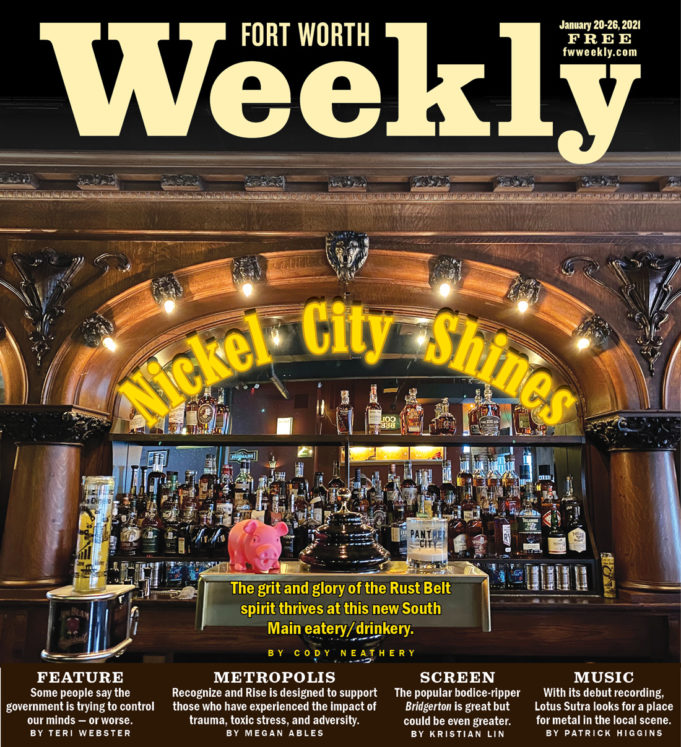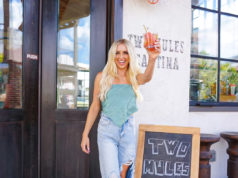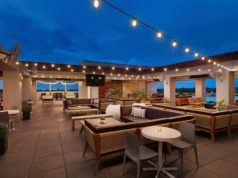When relocating to new real estate, we frequently seek sources to remind us of something former and familiar. Sometimes we discover that acquaintance au courant without attempt. And if it doesn’t exist, we are afforded the ability to roll up our sleeves and build it.
While Buffalo, New York, is a long way away from Fort Worth (1,549 miles to be exact) that’s precisely what Buffalo native Travis Tober did.
With Buffalo, alternatively coined Nickel City, a nickname derived from the obsolete nickel of the same name, Tober borrowed that moniker for his acclaimed Austin bar as one of several nods to his hometown. He followed suit for the sister location which opened in October on South Main Street, albeit one year behind schedule.
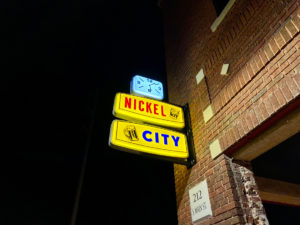
Photo by Cody Neathery.
Paying reverence to his family, a pristine collection of vintage alcohol signs for Schlitz and Canadian Club emerge from dated brick walls that recall memories of his grandfather’s bar, where Tober found work during his teenage years, with pinball machines that pay respect to those located in his father’s bar. Maroon and gray checkered tiles and mustard yellow curved booths inspired by his high school colors greet your entrance, although eyes are immediately lured to a commanding triple arch Brunswick bar aged 115 years and bought from auction in Cincinnati. Heads of carved lions keep guard over an expansive inventory of liquor bottles that glow under Edison bulbs turned tightly into the mouths of the felines.
A brightly lit marquee of ever-changing jokes shares wall space with a menu board of classic bar food complete with mix-matched pricing which yields wings (created at Buffalo’s Anchor Bar in 1964) in one- or two-pound increments, fried cheese curds, a fried bologna sandwich, and a slider that begs to be a normal-sized smash burger, in addition to juicy onion rings and a Coney dog serviced from the on-site food truck.
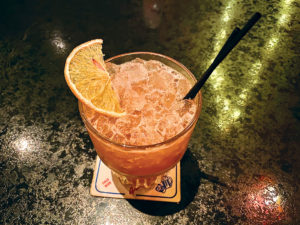
While a solo TV hangs on the distant end of the bar near the patio doorway, rarely is it on as this space conjures more community than exclusivity. Another sepia-toned sentimental beer sign might offer more usage if not for the occasional screen time demanded by sports.
Sounding off with stages of familiarity, well known, lesser known, and unknown begin the menu’s stroll into the cold beer and mixed drinks territory. An Old Pal’s rye is leveled off by splashes of apertivo and dry vermouth, rendering it a distant relative to the Old Fashioned. The Alabama Slammer, a drink with an appearance in the 1971 Playboy Bartender’s Guide, trades the original Southern Comfort for peach-infused bourbon piggybacked by peach bitters, amaretto, gin and “magic” OJ. Novelty turns serious when a Ramos gin fizz captures the youthful flavors of Fruity Pebbles cereal.
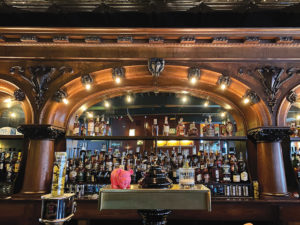
Lesser-known cocktails aren’t actually that when understanding the beverages were actually created by popular bartenders from various cities. Former New York City barman and author Jim Meehan makes an appearance with his mezcal mule recipe, followed by fellow New Yorker Sam Ross’ scotch-based Penicillin that leverages flavors of ginger, honey, and lemon floated by 10-year Laphroaig scotch. Step into the unknown with a Coco Beware, which delivers coconut-washed Maker’s Mark, apricot liqueur, lemon, and honey served with a personal-sized carafe to continue pouring on your own.
If this seems like a lot to swallow, wait, there’s even more.
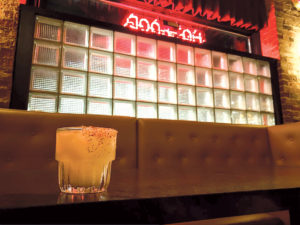
Boilermakers fluctuate from customary, such as Coors and Jim Beam, to irregular, like when a Wild Acre agave beer is met with mezcal and Montenegro. Or with the Turtle Back, which rattles with a Martin House pickle beer and hums with Jameson Black Barrel. All this before surfing into the Pacific realm of Polynesia, which features classic tiki drinks, including a zombie and a Mai Tai.
They even have room for two frozen drinks, including the Irish coffee, similar to that of the original creation located at Erin Rose in New Orleans, and a strawberry Negroni.
An obscure element to Nickel City’s buildout is that the walls give birth to an intimate 15-seat bar within the main barroom. Bar Bagazo, which translates to “husk” or “waste,” is a shrine to mezcal, the spiritual agave liquid with origins to Oaxaca, Mexico.
Nickel City’s foray into the South Main neighborhood already exudes the vibe of a tenured veteran of the local bar scene. Having characteristics of a blue-collar dive, a dime a dozen in the Northeast and Midwest, it feels like a bar made for everyone. As the South Main area continues to develop, Nickel City will subsequently take part settling in somewhere between something familiar and something well-known.



